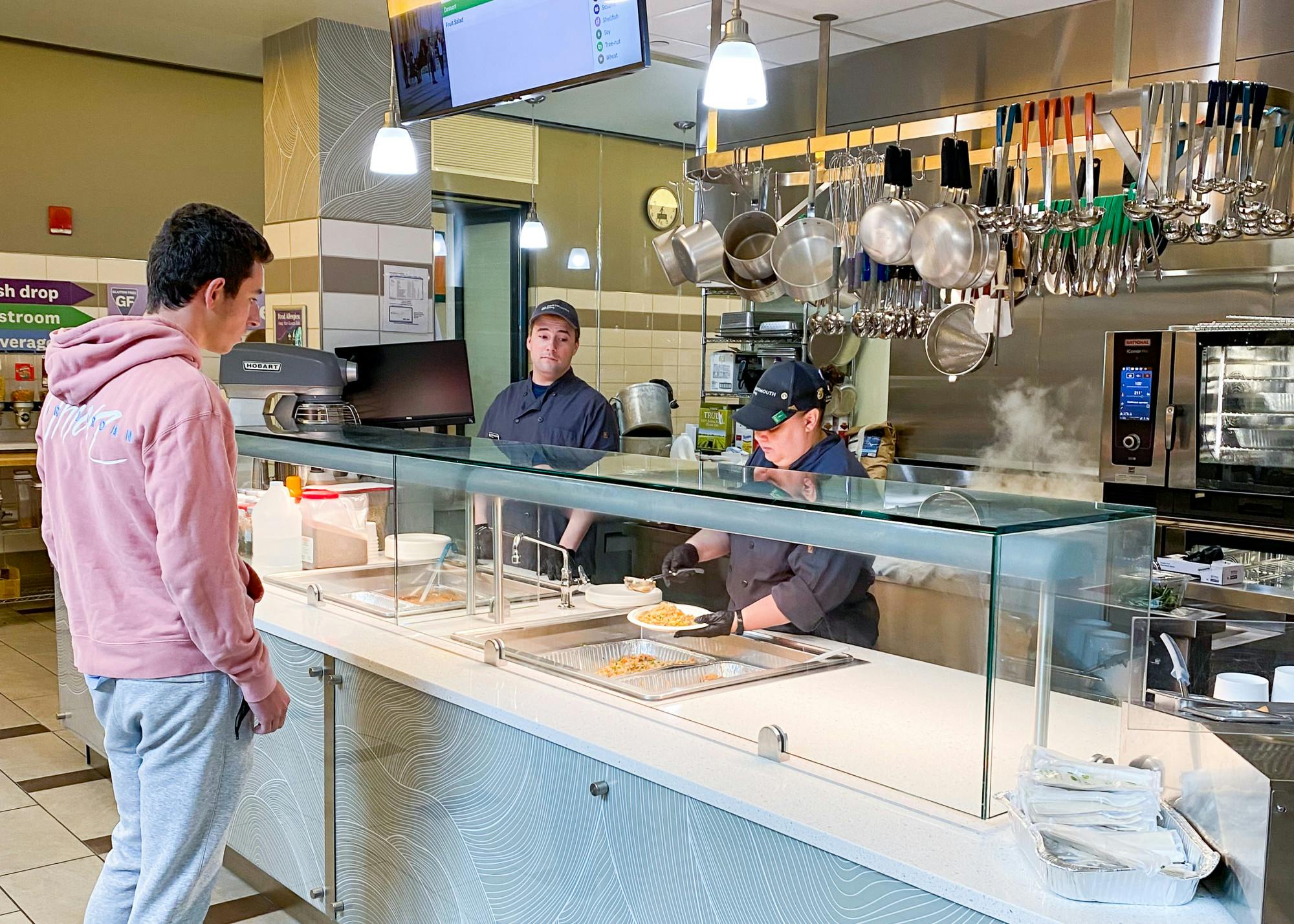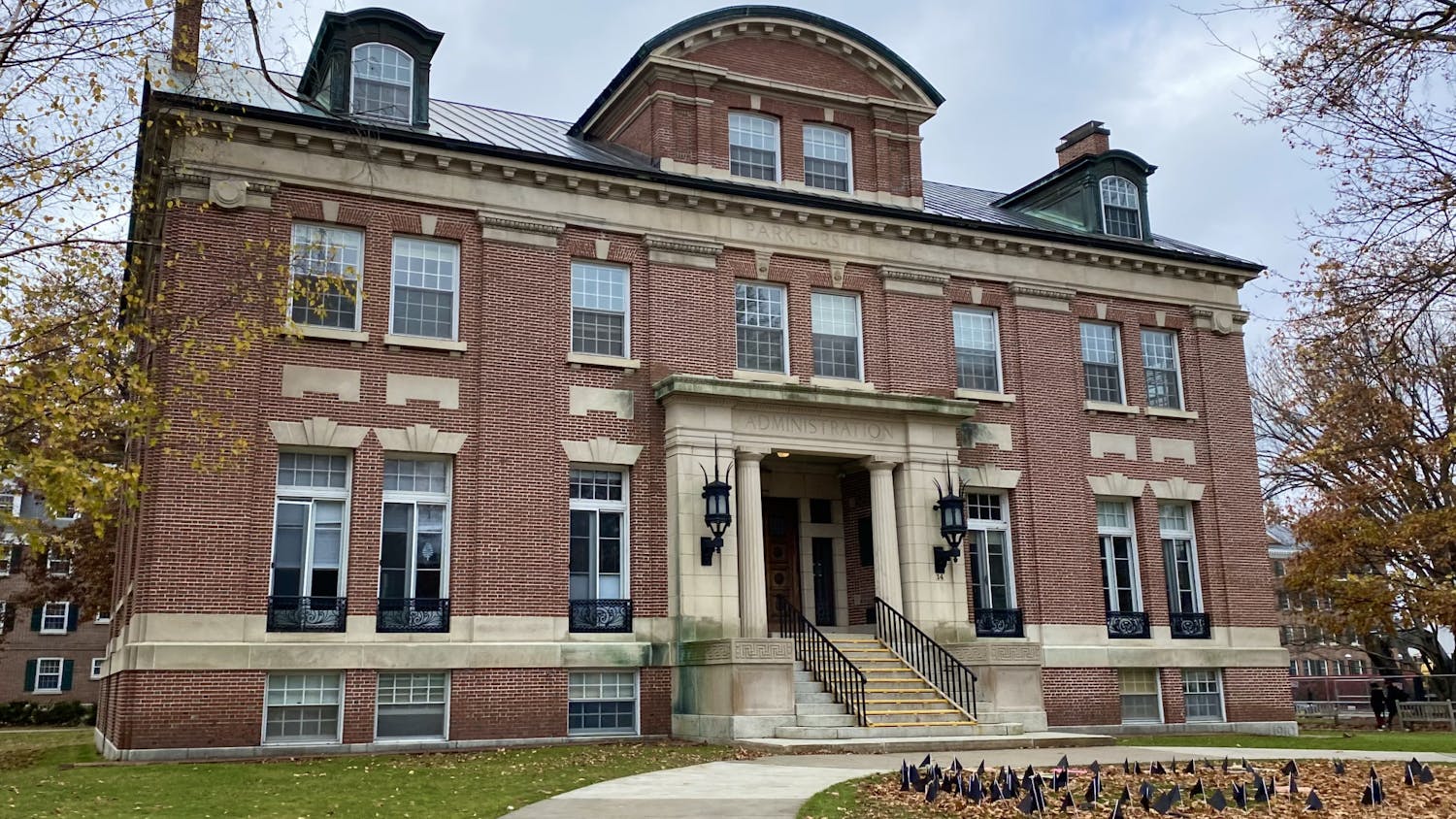There was an air of mystery in the Class of 1953 Commons this summer. With floor to ceiling tarps covering the once beloved sandwich and salad station, the construction of “The A9” station — a new dining serving area that is free of the top nine allergens: dairy, eggs, peanuts, tree nuts, fish, shellfish, sesame, wheat and soy — garnered curiosity among students.
Although the station may look similar to its predecessors, the A9 station has undergone extensive planning for over two years, according to Dartmouth Dining director Jon Plodzik. Plodzik also relayed that the new station is equipped with Food Allergy Research and Education-certified A9 recipes and is designed as a self-contained kitchen and serving area to avoid cross contamination. The serving area was created primarily as a response to an increasing number of students with multiple allergies.
“This station allows [the dining experience] to be more inclusive,” Plodzick said. “It allows folks to be really, really safe.”
This ability to have a safe meal was appealing for students with allergies. Dara Casey ’25, who has a gluten and nut allergy, was thrilled to have a place to eat where she could feel “comfortable” and safe eating at. She appreciated that Dartmouth Dining workers at the station serve the food, unlike many other stations which allow students to serve themselves, so nonallergic students could not accidentally contaminate food. Similarly, Jess Bargamian ’25, who suffers from celiac and lactose intolerance, was also excited to always have a gluten and dairy free option without fear of cross contamination, particularly because they serve the dishes on paper plates.
“I know [the A9 station is] now always going to be dairy free and gluten free, which makes it a little easier because I can definitely always have the option,” Bargamian said. “The gluten free meal would [occasionally] be mac and cheese … so sometimes that was an issue.”
With the opening of the allergen-free station on Sept. 11, students with and without allergies got to see — and taste — these new options. Lilly Brown ’25, who does not have any of the A9 allergies, was pleasantly surprised.
“The other day I got my whole meal from the station for dinner, and [the food was] all really good,” Brown recalled. “It tasted better than I would have expected with so many allergy accommodations.”
Other students, such as Bargamian, still expressed concern that the food may lack flavor and taste when accommodating so many allergens at once, although she does appreciate that she will always have a plain and simple food option. Brody Thompson ’24, who is allergic to fish, shellfish, peanuts and tree nuts — as well as legumes (which aren’t covered by the A9) — also feels that accounting for all nine allergies “limits the food quality.”
Nevertheless, since the A9 station accommodates multiple allergies, this new addition to Foco has made it easier for Dartmouth Dining to concentrate their efforts on helping students with dietary restrictions. According to Dartmouth Dining registered dietician Elizabeth Rosenberger, the A9 station is certified gluten free, and will now act as the main station for gluten-free students.
However, as A9 opened, the former gluten-free station, which was free of gluten but not the other eight major allergens, closed. Some gluten-free students expressed disappointment at this reduction of the gluten-free station as a consequence of A9’s opening.
After Casey got sick numerous times from eating at Foco due to cross contamination and improper labeling last year, she met with Rosenberger to advocate for gluten free students. This ultimately led to a dedicated gluten-free freezer with frozen meals. The opening of the A9 station has also coincided with the removal of this freezer, as well as a smaller freezer with gluten-free pastries, which has impacted some students.
“Being gluten free in general is just really difficult, and even though there’s the A9 station, that doesn’t necessarily make up for all the other dishes that I can’t eat as someone who’s gluten free,” Bargamian said. “So I think it’s good to have some more options, and the freezer was really good for that. I don’t see a reason they should have taken that away.”
Eli Friedman ’25, who also has celiac, saw the gluten-free options in Foco as “lackluster” before and doesn’t believe options have improved with the opening of the A9 station.
Gluten-free students are not the only ones feeling the consequences of the allergen-free station. With a legume allergy, Thompson said he derives a lot of his protein from dairy, which the A9 station does not serve. Moreover, after his first time trying the A9 station and being incorrectly told an item did not contain peas by the dining worker, Thompson suffered an allergic reaction. He added that he no longer feels comfortable using the station after this incident, especially because he says A9 does not clearly label the food’s ingredients.
“Gluten-free [products] use a lot of pea protein, so by having the station also be wheat free, I can’t eat there [even though] the station was meant for someone like me with a lot of allergies,” Thompson explained.
Thompson — who has four of the top nine allergies — had few issues with Foco in the past and was “shocked” why they even needed to create such a station. Bargamian and Friedman also cited being able to navigate Foco more easily prior to the opening of the station. Nonetheless, some students like Friedman understand that this may have been beneficial to students with multiple allergies.
“This [new station] is a significant help to the people with multiple dietary restrictions, especially for freshmen [on the Ivy Unlimited Plan] who have [almost] no option but to eat on campus,” Friedman said.
Students also had varying perspectives on the location of the A9 station. Brown liked that the new station created a less congested main Foco area, as lines are now concentrated in the back corner by Ma Thayer’s, the kosher station and the new sandwich station. On the other hand, Friedman felt that there is more attention drawn to students with allergies “from the vantage of dark side as opposed to the corner next to the kosher station.” Bargamian was grateful for A9’s easy access but found its location in the center of the dining hall unnecessary for a station that not a lot of people need to use.
However, Dartmouth dining chose the A9 station location with accessibility in mind, according to Plodzik. He said that the location is in an ideal spot “that allows it to be part of the main program.” Plodzik also said the station’s location allows it to support the ventilation system and kitchen appliances required to cook the array of A9 meals.
“We have some really, really state of the art equipment in that station,” Dartmouth Dining executive chef Christopher Kaschak explained. “We could literally do anything from brazing to overnight roasting to air frying.”
Kaschak is open to ideas from the student population and mentioned that they are working on a dessert option and french fries for allergy students.
The A9 station has encountered both successes and challenges throughout its opening last week, helping some students and limiting others. Ultimately, as the new serving area receives feedback from students and other members of the Dartmouth community, A9 will continue to evolve, addressing its goal of meeting as many dietary needs as possible.




